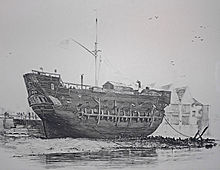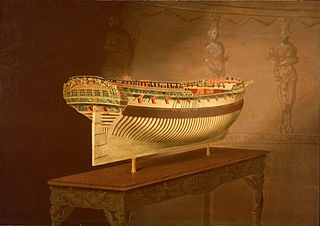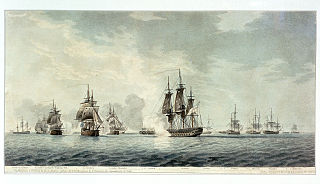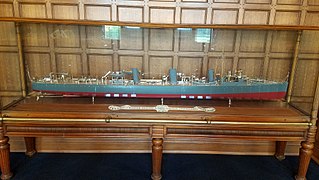| Name | Years in service | Location | Comments |
|---|
| HMS Antigua | 1804–1816 | | Antigua was the former French privateer Egyptienne, which Hippomenes captured in 1804. |
| HMS Antelope | 1824–1845 | Bermuda | Antelope was a 50-gun Fourth-rate launched in 1802. She was used as a troopship from 1818, was placed on harbour service from 1824 and was broken up in 1845. |
| HMS Argenta | 1919–1925 | Belfast Lough Northern Ireland | Argenta was a U.S. cargo ship purchased as a hulk to intern Irish Republicans as part of Britain's 1922 Special Powers Act internment strategy [4] following the events of Bloody Sunday (1920). [5] HMS Argenta was scrapped in 1925. |
| HMS Bellerophon | 1815–1824 | Sheerness | Bellerophon was a 74-gun Third-rate launched in 1786. Having taken part in the Battle of Trafalgar, she became a prison hulk in 1815, was renamed Captivity in October 1824 and was sold out of service in January 1836. [6] |
| HMS Belliqueux | 1814–1816 | | Belliqueux was a 64-gun Third-rate launched in 1780 at Blackwall. She was used as a prison hulk from 1814 and broken up in 1816. |
| HMS Briton | 1841–1856 | Portsmouth | Briton was built in 1812, Chatham. |
| HMS Canada | 1810–1834 | Chatham | Canada was a 74-gun Third-rate launched in 1765. She became a prison hulk in 1810 and was broken up in 1834. |
| HMS Captivity | 1796–1816 | Gosport and Devonport | The first Captivity was a former 64-gun Third-rate launched in 1772 as HMS Monmouth. She became a prison hulk and was renamed Captivity in 1796. She was broken up in 1816. |
| HMS Captivity | 1824–1836 | Gosport and Devonport | The second Captivity was a former 74-gun Third-rate launched in 1786 as HMS Bellerophon. She became a prison hulk in 1815 and was renamed HMS Captivity in 1824. She was sold in 1836. |
| Censor | 1776–? | Woolwich | Censor was a former French Navy frigate of 731-tons. With Justitia I and Justitia II, she was one of the first prison hulks, and supplied by ship owner and merchant Duncan Campbell. |
| HMS Ceres | 1787–1797 | Woolwich | Ceres was a 32-gun Fifth-rate launched in 1781 and broken up in 1830. |
| HMS Chatham | 1793–1805 | Plymouth | Chatham was a 50-gun Fourth-rate launched in 1758. She was used for harbour service from 1793 and was a powder hulk from 1805. She was renamed Tilbury in 1810 and was broken up in 1814. |
| HMS Coromandel | 1827–1853 | Bermuda | Coromandel was a 20-gun storeship, formerly an East Indiaman that the Admiralty purchased in 1804, commissioned as a 56-gun Fourth-rate, and named HMS Malabar. She was refitted as a storeship in 1805 and renamed Coromandel in 1815. She became a prison hulk in 1827 and was broken up in 1853. [6] |
| HMS Crown | 1798–1802
1806–15 | Portsmouth | Crown was a 64-gun third rate ship launched in 1782. She was converted to serve as a prison ship in 1798, used as a powder hulk from 1802 until 1806, and then restored to a prison ship until being put in ordinary in 1815. She was broken up in 1816. |
| HMS Cumberland | 1830–1833 | Chatham | Cumberland was a 74-gun Third-rate launched in 1807, Northfleet. She was converted to a prison hulk in 1830 and was renamed Fortitude in 1833. She was put on the sale list in 1870 and was subsequently sold. |
| HMS Dasher | 1832–1838 | Woolwich | Dasher was an 18-gun sloop launched in 1797. She became a prison hulk in 1832 and was broken up in 1838. [6] |
| HMS Defence | 1850–1857 | Woolwich and Portsmouth | Defence was a 74-gun Third-rate ship of the line, built in 1815 and accidentally burnt in 1857. Wreck broken up in 1857. [6] |
| HMS Defiance | 1813–1817 | | Defiance was a 74-gun Third-rate launched in 1783 Rotherhithe. She was used as a prison hulk from 1813 and was broken up in 1817. |
| HMS Discovery | 1818–1834 | Woolwich and Deptford | Discovery was a 10-gun sloop launched and purchased in 1789. She was commanded by Captain George Vancouver on his voyage of exploration from 1791 to 1795. She was converted to a bomb vessel in 1799, a prison hulk in 1818 and was broken up in 1834 at Deptford. [6] |
| HMS Dolphin | 1824–1830 | Chatham | Dolphin was originally launched as an East Indiaman named Admiral Rainier, which the Navy bought and renamed HMS Hindostan. The Admiralty purchased her in 1804 for service as a 50-gun Fourth-rate. She was converted into a 20-gun storeship in 1811. She was renamed again in 1819 as Dolphin, and once more in 1831 as Justitia, when she became a prison hulk. She was finally sold in 1855. |
| HMS Dromedary | 1825–1864 | Woolwich and Bermuda | Dromedary was an East Indiaman that the Navy purchased in 1805. First named Howe and then renamed Dromedary in 1808. She was converted to a convict ship in 1819, became a prison hulk at Bermuda in 1825, and was broken up there in August 1864. [6] |
| HMS Dunkirk | 1782–1792 | Plymouth | Dunkirk was a Fourth-rate, built in 1754 at Woolwich. Converted to guardship in 1782, at Plymouth. Sold in 1792. |
| HMS Edgar | 1814–1835 | | Edgar was a 74-gun Third-rate launched in 1779. She was converted to a prison hulk in 1813, renamed Retribution in 1814, and broken up 1835. |
| HMS Essex | 1824–1834 | Cork | HMS Essex was originally the USS Essex of the United States Navy, a sailing frigate that participated in the Quasi-War with France, the First Barbary War, and in the War of 1812. The British captured her in 1814 and she then served as HMS Essex until she was sold at public auction in 1837. |
| HMS Euryalus | 1825–1847 | Chatham and Gibraltar | Having taken part in the Battle of Trafalgar and briefly served as Admiral Collingwood 's flagship, Euryalus was decommissioned in 1825 and converted into a prison hulk for boys at Chatham. In 1847 she was moved to Gibraltar, and was sold for breaking up in 1860. [6] |
| HMS Fortitude (Formerly HMS Cumberland) | 1833–1844 | Chatham | HMS Cumberland was a 74-gun Third-rate launched in 1807. She was converted to a prison hulk in 1830 and was renamed Fortitude in 1833. She was put on the sale list in 1870 and was subsequently sold. |
| HMS Fortitude (1780) | 1795–1820 | Chatham | Fortitude was a 74-gun Third-rate ship of the line launched in 1780. She served as a prison hulk from 1795 and was broken up in 1820. |
| HMS Ganymede | 1819–1838 | Chatham and Woolwich | Ganymede was the French frigate Hébé captured in 1809. She was converted to a prison hulk in 1819 and broken up in 1838. |
| HMS Gelykheid | 1807–1814 | Gillingham | Equally Gelijkeidt, Gelykheidt, or Gelikheid. On 8 May 1800 a court martial was held at Sheerness, on board HMS Savage on Lieutenant Wheatly and his Clerk, of the Gelykheid prison ship, at Gillingham, for drunkenness and neglect of duty, ungentlemanlike conduct, embezzlement of stores, tyranny, and oppression, but the charges being malicious and ill founded, they were acquitted. In 1803 was stationed in the Humber as Guardship and in 1807 she was fitted out as sheer hulk at Falmouth. She was disposed of in 1814. |
| HMS Glory | 1809–1814 | | Glory was a 90-gun Second-rate launched in 1788. She was converted to a prison hulk in 1809, a powder hulk in 1814, was and broken up in 1825. |
| HMS Goree | 1814–1817 | Bermuda | Goree was the 16-gun sloop of war HMS Favourite launched in 1794. The French captured her in 1806 and renamed her Favorite; the British recaptured her in 1807 and renamed her HMS Goree. She became a prison hulk in Bermuda in 1814 and was broken up in 1817. |
| HMS Hardy | 1824–1833 | | Hardy was a 14-gun gun-brig launched in 1804. She was used as a storeship from 1818 and a hospital ship from 1821, before being sold in 1835. |
| HMS Hebe | 1839–1852 | Woolwich | Hebe was a 46-gun Fifth-rate launched in 1826, made a receiving ship in 1840, hulked in 1861, and broken up in 1873. [6] |
| HMS Hector | 1808–1816 | | Hector was a 74-gun Third-rate launched at Deptford in 1774 and converted to a prison hulk in 1808, and broken up in 1816. |
| HMS Justitia | 1812–1830 | Sheerness | Vice Ad. Richard Onslow seized the Zeeland from the Dutch at Plymouth on 4 March 1796. She was renamed Justitia in 1812 and broken up in 1830, when her name was transferred to Dolphin. |
| HMS Justitia | 1830–1855 | Woolwich | Justitia was originally launched as an East Indiaman named Admiral Rainier. The Admiralty purchased her in 1804 to use as a 50-gun Fourth-rate, and named her HMS Hindostan. She was converted into a 20-gun storeship in 1811. She was renamed again in 1819 as Dolphin, and once more in 1830 as Justitia, when she became a prison hulk. She was finally sold in 1855. |
| HMS Jersey | 1776–1783 | New York | Jersey was a 60-gun Fourth-rate, built in 1736 as Plymouth. She was used as a prison hulk in New York during the American Revolutionary War, and subsequently burned by the British before they abandoned New York in 1783. |
| HMS Laurel | 1798–1821 | Portsmouth | Laurel was the Dutch sloop Sireene captured at the capitulation of Saldanha Bay in 1796. She was initially named HMS Daphne, but in 1798 was converted to a convict ship under the name of HMS Laurel. She was sold in 1821. |
| HMS Leven | 1827–1848 | Woolwich and Deptford | Leven was launched in 1813 at Ipswich. She became a hospital ship in 1827 and then a prison hulk at Chatham. She became a receiving ship at Limehouse in 1842 and was broken up in 1848. |
| HMS Leviathan | 1816–1848 | Portsmouth | Leviathan was a 74-gun Third-rate ship of the line launched in 1790 at Chatham. She fought at the Battle of Trafalgar, was used as a prison hulk from 1816. In October 1846 she was used as a naval target, and was sold out of service in 1848. [6] |
| HMS Lion | 1816–1837 | Gosport | Lion was a 64-gun Third-rate launched in 1777. She was used as a sheer hulk from 1816 and was sold for breaking up in 1837. |
| Lord Stanley | 1777 | Halifax, Nova Scotia | Lord Stanley was a mercantile snow of 150 tons (bm) that a Massachusetts privateer captured and the Royal Navy recaptured. She transported prisoners from the American colonies to Halifax and then remained there as a prison ship. |
| HMS Medway | 1850–1862 | Bermuda | Medway was a 74-gun Third-rate launched in 1812. She was used as a prison hulk after 1847 and was sold in 1865. |
| HMS Menelaus | 1832–1897 | | Menelaus was a Royal Navy 38-gun Fifth-rate frigate, launched in 1810 at Plymouth. In 1820 she moved to Chatham and in 1832 became a quarantine hulk. On 19 December 1848 she accepted sick from the convict ship Hasemey, which called in at Portsmouth en route from the River Thames to New South Wales with a number of cases of cholera and diarrhoea. She remained with the Quarantine Service until 1890 and was sold in 1897. |
| HMS Narcissus | 1823–1837 | | Narcissus was a 32-gun Fifth-rate launched in 1801 at Deptford. She became a prison hulk after 1823, and was sold in 1837. |
| HMS Oiseau | 1810–1816 | | Oiseau was a 36-gun Fifth-rate, originally a French ship called Cleopatre but captured in 1793. She was converted to a prison hulk in 1810, later lent to the Transport Board and sold in 1816. |
| HMS Owen Glendower | 1842–1862 | Gibraltar | Owen Glendower was launched in 1808 at Humber. She became a prison hulk in Gibraltar 1842, a receiving ship in 1876, and was sold in 1884. |
| HMS Pegase | 1794–1810 | Portsmouth | Pégase was a 74-gun ship of the line of the French Navy, captured in 1782. She served as a prison ship from 1794, a prison hospital ship from 1801, returned to being a prison ship in 1803 and was lent to the Transport Board in 1810. In 1811, she was still a Prison Hospital Ship (death on board of POW Pascal FURIC, a French sailor, "phthisis pulmonalis", on 6 May 1811) ref.: TNA ADM 103/357. |
| Phoenix | 1824–1837 | Sydney | Phoenix was a merchant sailing vessel damaged upon the Sow and Pigs Reef within Sydney Harbour and converted to a prison hulk. |
| HMS Portland | 1802–1817 | Langstone Harbour | Portland was a 50-gun Fourth-rate launched in 1770 at Sheerness. She was converted to a 10-gun storeship in 1800 and a prison hulk in 1802. She was sold in 1817. |
| HMS Prothee | 1795–1815 | Portsmouth | Protée was a 64-gun ship of the French Navy, captured in 1780. She served as a prison ship from 1795 until being broken up in 1815. |
| HMS Prudent | 1779–1814 | Woolwich | Prudent was launched in 1768 at Woolwich Dockyard. She was on put on harbour service in 1779 and sold in 1814. |
| HMS Racoon | 1819–1838 | Portsmouth | Racoon was an 18-gun sloop launched in 1808 at Yarmouth. She was used as a hospital ship for convicts from 1819 and was sold in 1838. |
| HMS Resolute | 1844–1852 | | Resolute was a 12-gun gun-brig launched in 1805 in Dover. She was used as a tender from 1814, a diving bell vessel from 1816 and a prison hulk from 1844. She was broken up in 1852. |
| HMS Retribution | 1814–1835 | Woolwich and Sheerness | Retribution was a prison hulk launched in 1779 as the 74-gun Third-rate HMS Edgar. Edgar was converted into a prison hulk in 1813, renamed Retribution in 1814 and broken up in 1835. |
| HMS Royalist | 1856 | | Royalist was originally HMS Mary Gordon of six guns, purchased in China in 1841. Became a hulk in 1856. |
| HMS Savage | 1804–1815 | Woolwich | Savage was a 14-gun sloop launched in 1778. She became a hulk in 1804 and was sold in 1815. |
| HMS Stirling Castle | 1839–1855 | Portsmouth | Stirling Castle was a 74-gun Third-rate ship of the line launched in 1811 at Rochester. She became a hulk in 1839. |
| HMS Success | 1814–1820 | Hobart | Success was a 32-gun Fifth-rate launched in 1781 at Liverpool. She became a prison hulk in 1814 and was broken up in 1820. |
| HMS Sulphur | 1843–1857 | Woolwich | Sulphur was a 10-gun bomb vessel launched in 1826. She was used as a survey ship from 1835, and for harbor service from 1843. She was broken up in 1857. |
| HMS Surprise | 1822–1837 | Cork | Surprise was a 38-gun frigate, previously named HMS Jacobs and launched in 1812. She became a prison hulk in 1822 and was sold in 1837. |
| HMS Temeraire | 1812–1815 | River Tamar | Temeraire was a 98-gun Second-rate launched in 1798 at Chatham. She served as a prison hulk between 1812 and 1815, then as a receiving ship until 1836, and was broken up in 1838. |
| HMS Tenedos | 1843–1875 | Bermuda | Tenedos was a 38-gun Fifth-rate launched in 1812. She was used as a prison hulk from 1843 and was broken up in 1875. |
| HMS Thames | 1841–1863 | Bermuda and Deptford | Thames was a 46 gun Fifth-rate launched in 1823. She was converted to a prison hulk in 1841, and sank at her moorings in 1863. |
| HMS Unite | 1832–1858 | Woolwich | Unite was a 40-gun Fifth-rate captured from the French in 1793. She was taken into service as HMS Imperieuse and was renamed Unite in 1803. She was on harbour service from 1832 and was broken up in 1858. |
| HMS Vengeance | 1808–1816 | Portsmouth | Vengeance was a 74-gun third rate launched in 1774. She became a prison ship in 1808 and was broken up in 1816. |
| HMS Warrior | 1840–1857 | Woolwich | Warrior was a 74-gun Third-rate ship of the line launched in 1781. She became a receiving ship after 1818, a prison hulk after 1840, and was broken up in 1857. |
| HMS Weymouth | 1828–1865 | Bermuda | Weymouth was a 36-gun Fifth-rate, previously the East Indiaman Wellesley. She was purchased in 1804, and by 1811 had been converted into a 16-gun storeship. She was used as a prison hulk from 1828 and was sold in 1865. |
| HMS York | 1820–1852 | Gosport | York was a 74-gun Third-rate launched in 1807 at Rotherhithe. She was converted to a prison hulk in 1819 and served as a prison hulk at Gosport and London from 1820 until 1848 when a serious rebellion broke out. Typically she confined about 500 convicts. She was taken out of service and broken up in 1854. Hulks were re-banned in England. |



















